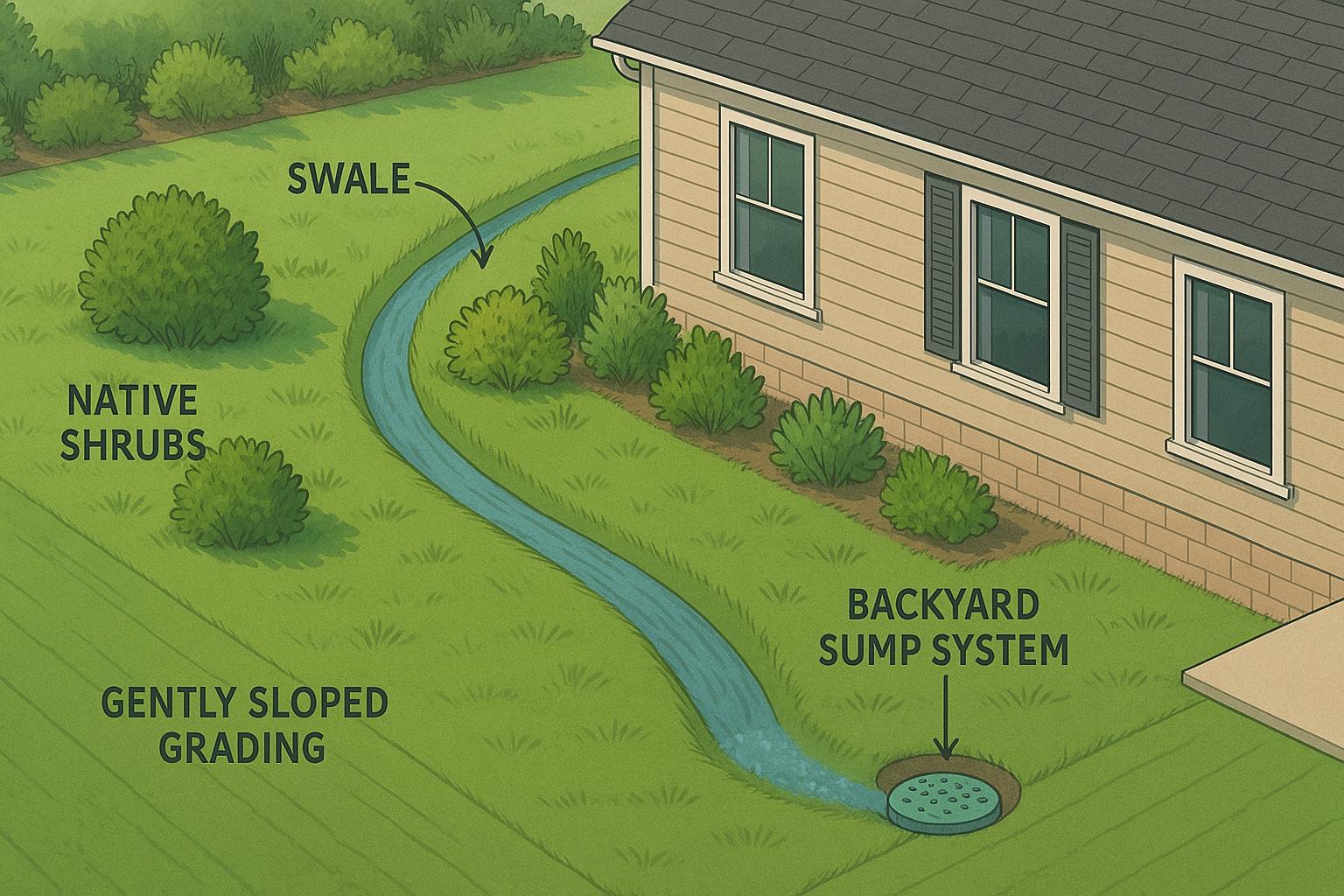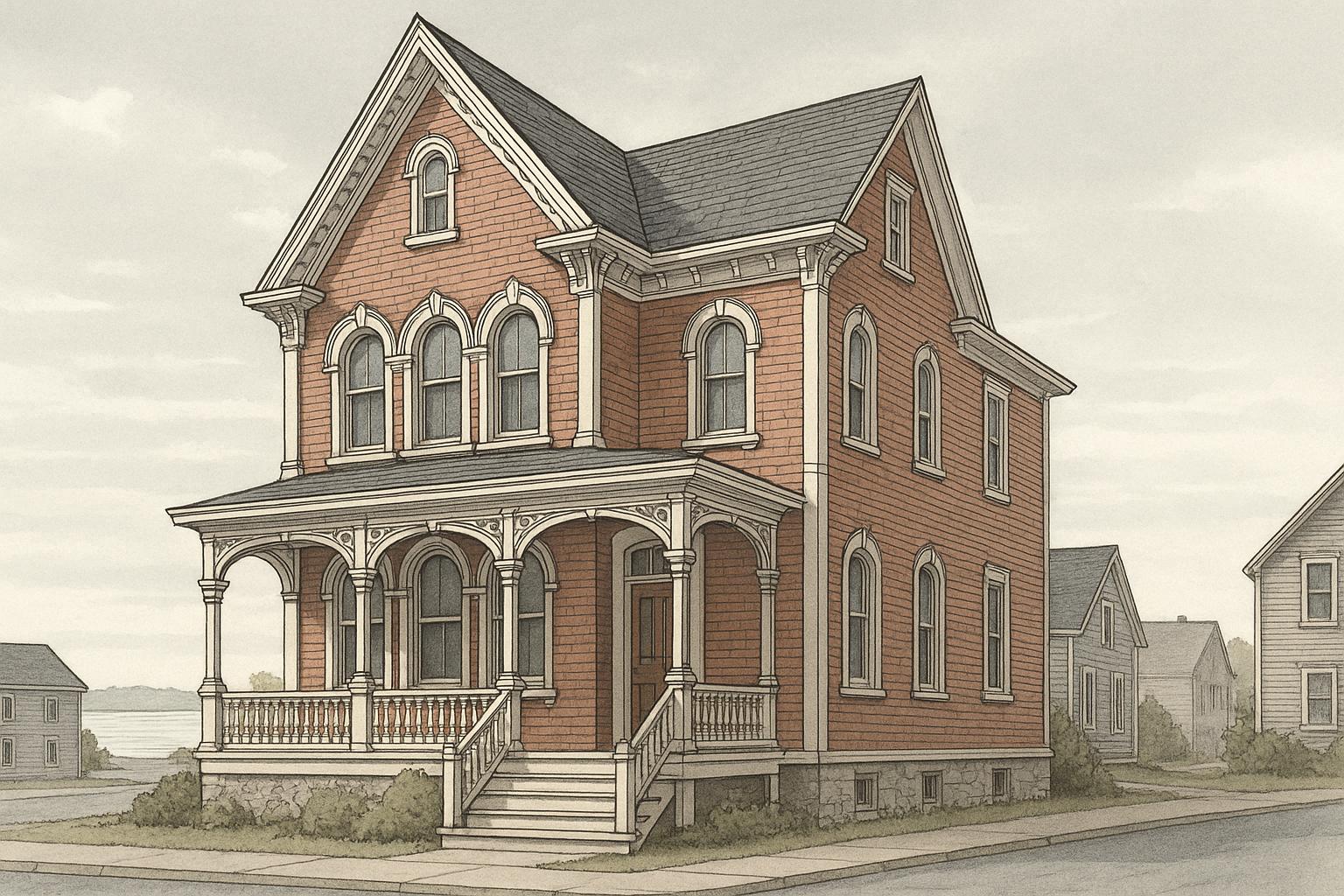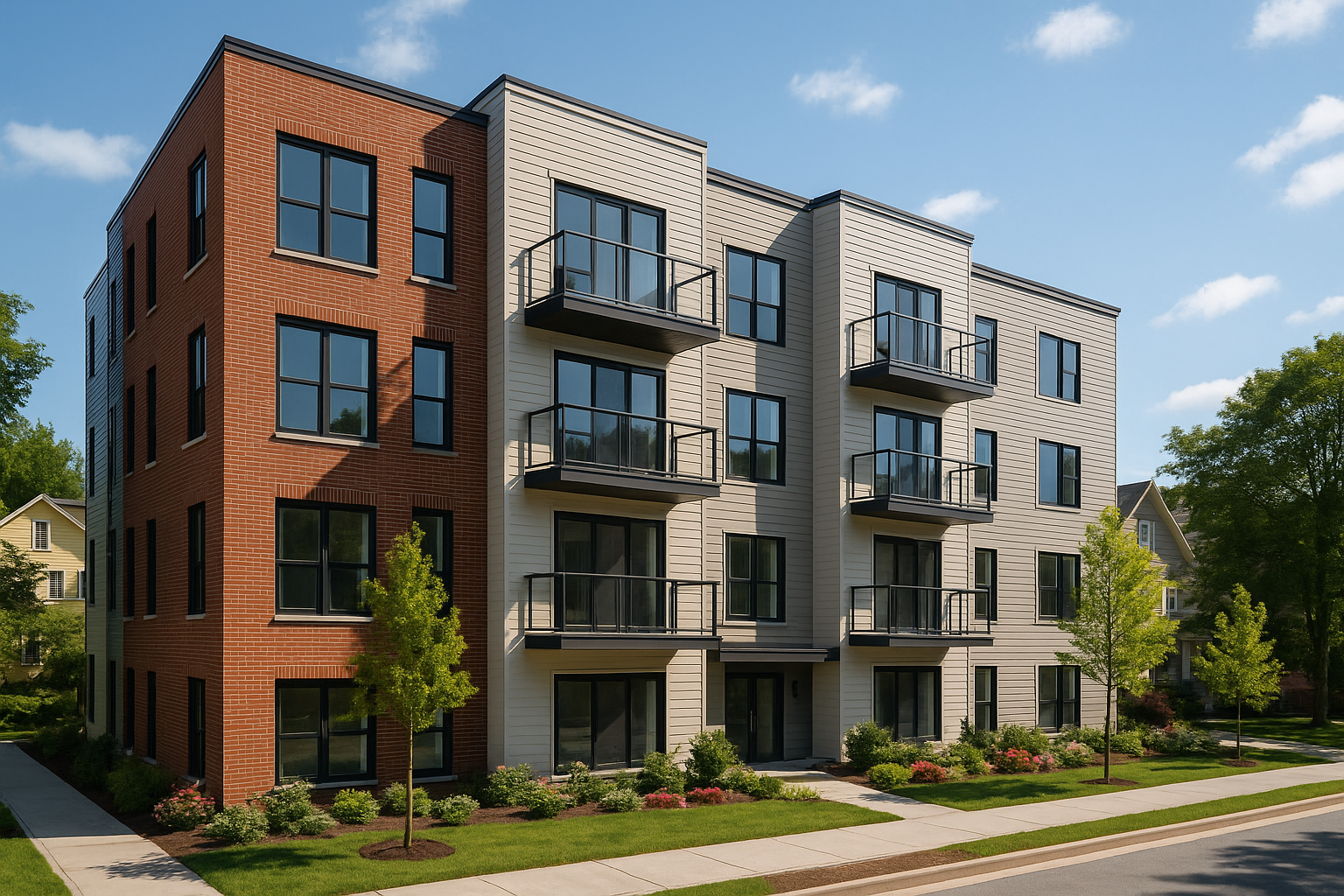Stacked townhouses in Halifax Regional Municipality (HRM) are a smart way to address housing demand while generating rental income. These multi-unit buildings comply with HRM's by-right zoning regulations, meaning property owners can build without needing variances or rezoning. Here's what you need to know:
- What Are Stacked Townhouses? Multi-unit homes with vertical layouts, offering 2–4 units per structure. Each unit has private entrances and amenities like kitchens, bathrooms, and outdoor spaces.
- By-Right Zoning: If your project meets HRM's Land Use By-law standards (e.g., setbacks, height limits, parking), you can skip public consultations and variances, speeding up approvals.
- Rental Market Demand: Two-bedroom units (93–111 m²) rent for $1,950–$2,100/month, making them a strong investment.
- Construction Options: Integrated design-build methods simplify timelines and budgets, reducing risks compared to fragmented construction.
- Financing: The CMHC MLI Select program offers 95% financing and 50-year amortization, making it easier to achieve positive cash flow.
Stacked townhouses combine efficient use of land with features tenants want, like private outdoor spaces, energy-efficient systems, and in-unit laundry. With clear zoning, reliable returns, and financing options available, they’re a practical choice for property owners in HRM.
By‑Right Zoning: What You Can Build in HRM
In Halifax Regional Municipality (HRM), the zoning framework simplifies the process of developing stacked townhouse projects. If your project meets the existing zoning and building code requirements, you can qualify for by‑right approval. This process skips the need for variances or rezoning, removing discretionary reviews and the uncertainties they bring [1]. Here's a closer look at the zoning categories and by‑law standards that shape these developments.
Key Zoning Categories for Stacked Townhouses
HRM's Land Use By‑law identifies several zoning categories where by‑right development is permitted. While the exact details vary, many established residential zones allow for multi‑unit projects. To determine the specific zoning category for your property and understand its requirements, it's a good idea to consult the official Land Use By‑law or speak with local planning officials.
Local By‑Law Standards
Meeting local by‑law standards is crucial for ensuring that stacked townhouse developments fit seamlessly into their surroundings. These standards typically cover essentials like lot sizes, building setbacks, height limits, parking requirements, and accessibility features. Following these guidelines not only speeds up the approval process but also helps create developments that align with HRM's broader planning goals.
Model Floor Plans: Designing for Market Demand and ROI
With HRM's by-right zoning simplifying approvals, choosing the right floor plan is key to maximizing your return on investment (ROI). The success of a stacked townhouse project hinges on floor plans that balance efficiency with tenant appeal. In HRM's competitive rental market, well-designed two-bedroom units consistently outperform other layouts, excelling in both rental rates and occupancy. Below are examples of layouts that deliver strong rental returns.
Common Stacked Townhouse Layouts
One popular design in HRM is the two-storey-over-two-storey configuration. In this setup, the ground-floor unit provides direct access to a private outdoor space, while the upper unit offers more privacy and the possibility of scenic views. These two-bedroom units typically range from 93 to 111 m² (1,000 to 1,200 sq ft), offering a comfortable space that appeals to long-term tenants.
Another option is the single-level, three-storey design, where each level contains a complete two-bedroom unit. This layout is particularly effective for sloped lots, offering multiple walkout access points. It also increases market flexibility by adapting to various lot conditions.
For property owners looking to appeal to a broader demographic, integrated designs that merge elements of these layouts can be a smart choice. These configurations allow for consistent two-bedroom units tailored to diverse tenant needs and lot conditions.
Features That Attract Tenants
Two-bedroom units in HRM's market command monthly rents between $1,950 and $2,100, making them an attractive investment. Here are some features that boost tenant interest and satisfaction:
- Open-concept main floors: Combining kitchen, dining, and living spaces meets modern tenant expectations while simplifying construction by reducing the need for additional walls.
- In-unit laundry: Properties with laundry facilities see shorter vacancy periods and better overall rental performance.
- Energy-efficient systems: Features like heat pumps, triple-pane windows, and enhanced insulation not only lower utility costs during HRM's long heating season but also align with the integrated design approach.
- Private outdoor spaces: Ground-floor patios or upper-level balconies provide tenants with valued outdoor access. Even small outdoor areas can significantly enhance tenant satisfaction and retention.
Floor Plan Comparison Table
| Layout Type | Unit Size | Monthly Rent Range | Construction Cost | Annual ROI Potential |
|---|---|---|---|---|
| 2-Bed Ground Floor | 93–111 m² (1,000–1,200 sq ft) | $1,950–$2,100 | $160,000–$200,000 | 14–18% |
| 2-Bed Upper Level | 93–111 m² (1,000–1,200 sq ft) | $1,950–$2,100 | $160,000–$200,000 | 14–18% |
Additional Considerations
Beyond the basics of cost and rent, thoughtful interior design plays a critical role in tenant satisfaction. Features like built-in closets, pantry spaces, and utility storage address common tenant concerns and encourage long-term retention. Flexible layouts are another advantage, allowing tenants to adapt their spaces for work-from-home setups or changes in household size. These small but impactful design choices can make all the difference in creating a desirable, tenant-friendly property.
Integrated vs Fragmented Construction: Choosing Your Approach
When it comes to stacked townhouse projects in HRM, the construction method you choose can make or break your project's budget and timeline. While earlier discussions have focused on the design advantages, this section dives into how your delivery method affects overall ROI. Traditional fragmented construction often leaves property owners juggling multiple contractors for tasks like design, engineering, permitting, excavation, and finishing. This approach tends to invite delays, budget overruns, and coordination headaches.
Fragmented Construction Challenges
Opting for fragmented construction means taking on the responsibility of managing a web of contractors, which can lead to a host of issues. Scheduling conflicts are common, costs frequently spiral by an average of 30–60%, and timelines often stretch beyond 18 months. Quality control becomes a patchwork effort, with separate warranties for different aspects of the build, adding to the stress.
Why an Integrated Design-Build Approach Works Better
The integrated design-build model offers a streamlined alternative with several standout advantages:
- One Team, One Responsibility: A single, unified team handles the entire project, sparing owners the hassle of managing multiple contractors.
- Predictable Costs: Costs are locked in before construction begins, reducing the risk of unpleasant financial surprises.
- Reliable Timelines: With all trades working under one roof, projects are completed within a fixed 6-month schedule, and penalties hold teams accountable for delays.
- Transparent Updates: Owners receive daily updates, including real-time photos and centralized reporting, keeping them in the loop every step of the way.
- Consistent Quality: A consolidated warranty and regular quality checks ensure every detail meets high standards.
Comparing the Two Approaches
The table below highlights the key differences between fragmented construction and the integrated design-build model, showing how the latter aligns better with financial and operational goals:
| Factor | Fragmented Construction | Integrated Design-Build |
|---|---|---|
| Cost Certainty | Overruns averaging 30–60% due to change orders | Fixed pricing determined before construction starts |
| Timeline | Often exceeds 18 months | Guaranteed 6-month completion with penalties for delays |
| Coordination | Owners must manage multiple contractors | Single point of contact for all project aspects |
| Quality Control | Separate warranties with potential gaps | Unified quality control with a consolidated warranty |
| Project Updates | Scattered updates from various sources | Centralized, real-time updates with daily photos |
| Risk Management | Owners bear most of the risks | Builder takes full responsibility for project success |
Choosing the right approach can significantly impact your project's success. With an integrated design-build model, you’re more likely to hit key objectives, such as achieving a 12–20% annual ROI, while tapping into HRM's thriving rental market. Well-constructed two-bedroom units in this area typically command rents between $1,950 and $2,100 per month, making a strong case for a streamlined, efficient construction process.
sbb-itb-16b8a48
Financial Details: Costs, Returns, and Financing Options
Understanding the financial side of your stacked townhouse project in HRM is crucial. Costs, returns, and financing options play a key role in determining your project's profitability.
Construction Cost Estimates
Building costs for a standard stacked townhouse start at approximately $160,000 per unit, with a minimum of four units required. That brings the total to $640,000, not including land expenses. This pricing includes high-quality features such as ductless heat pumps, triple-pane windows, quartz countertops, custom millwork, engineered hardwood flooring, and premium fixtures.
For those looking to maximize financing opportunities, the CMHC MLI Select program estimates construction costs at $200,000 per unit. While this adds a $40,000 premium per unit, it delivers 40% better energy efficiency compared to standard building codes. This efficiency often offsets the higher upfront costs through better cash flow and financing advantages.
If you're aiming for immediate rental income, you can opt for the Premium Rental Ready Package for an extra $15,000 per unit. This package includes Energy Star appliances, smart home features like keyless entry and thermostat controls, as well as window blinds and bathroom accessories. By bundling these items, you save over $3,000 per unit compared to buying them separately, while also eliminating the typical 60-day gap between construction completion and the start of rental income. These cost benchmarks create a solid foundation for generating strong rental returns.
Expected Rental Income and ROI
Stacked townhouses with modern finishes and energy-efficient features command premium rents in HRM's competitive market. Two-bedroom units, in particular, can generate annual returns ranging between 12% and 20% for property owners, making these projects a lucrative investment.
The quality of construction and tenant-focused amenities are key to achieving these returns. Features like ductless heat pumps, energy-efficient designs, and high-end finishes attract tenants willing to pay higher rents. Units that come with appliances and smart home technology often rent at the top end of the market while maintaining lower vacancy rates.
Cash flow typically becomes positive within the first year, especially when paired with smart financing options. For a four-unit project, monthly rental income ranges between $7,800 and $8,400, which is more than enough to cover mortgage payments, property taxes, insurance, and maintenance reserves when financed appropriately.
Financing Programs for Property Owners
Financing options can significantly boost your returns. The CMHC MLI Select program is particularly appealing for stacked townhouse developments. It offers 95% financing, meaning you only need a 5% down payment, compared to the usual 20%. Even better, it provides a 50-year amortisation period instead of the standard 25 years.
These terms create substantial cash flow benefits. With 95% financing, you achieve a 20:1 leverage ratio, far exceeding the 5:1 ratio typical of conventional mortgages. The extended amortisation period also lowers monthly payments, ensuring positive cash flow from the very start.
For example, a standard $640,000 project requires a $128,000 down payment, while an MLI Select project costing $800,000 needs only $40,000 down. This lower upfront cost allows you to allocate capital towards building more units, amplifying your investment potential.
| Financing Option | Down Payment | Amortisation | Monthly Payment | Cash Flow Impact |
|---|---|---|---|---|
| Standard Financing | 20% ($128,000) | 25 years | Higher payments | Break-even timeline |
| CMHC MLI Select | 5% ($40,000) | 50 years | Lower payments | Positive from day one |
| Leverage Ratio | 5:1 | Standard | Traditional | Limited expansion |
| MLI Select Ratio | 20:1 | Extended | Optimised | Multiple projects possible |
To take full advantage of MLI Select, you’ll need to integrate its energy efficiency requirements into your project from the start. These standards must be part of the initial design rather than added later. Partnering with builders experienced in MLI Select ensures your property qualifies for the program and that all necessary documentation is properly prepared for CMHC approval.
Building Stacked Townhouses with Confidence
Stacked townhouses in HRM present a solid opportunity for profitable development, thanks to the regulatory and financial insights discussed earlier. With by-right zoning, property owners can move forward without worrying about expensive variances or frustrating delays.
When guided by experienced professionals using an integrated design-build approach, these projects benefit from streamlined timelines, fixed costs, and appealing returns. Skilled builders handle the intricacies of local zoning requirements while managing every phase of the project under one cohesive team. This avoids the budget overruns often seen with fragmented construction processes [2][3]. It’s a strategy that aligns perfectly with the strong financial and tenant outcomes previously highlighted.
As outlined in the financial overview, combining expert planning with integrated construction leads to reliable annual returns. Programs like the CMHC MLI Select, offering 95% financing and 50-year amortization, further enhance the potential for positive cash flow from the very beginning.
Collaborating with seasoned professionals ensures that every design decision is aligned with both compliance and profitability [4]. This partnership provides the insight needed to establish realistic expectations for the long-term use of the property.
For property owners considering stacked townhouse development, the combination of favourable zoning and a unified construction approach delivers reliable returns and positions the project for market success.
FAQs
What makes by-right zoning in HRM an easier option for building stacked townhouses?
By-right zoning in HRM makes it easier to develop stacked townhouses by allowing property owners to build within the established zoning rules. There's no need to apply for variances or go through rezoning approvals, which means you can move straight to construction planning. This can save a significant amount of time and help avoid unnecessary delays.
With this approach, your project is designed to meet local zoning requirements from the beginning. It provides a clearer and more straightforward path to development, making it an effective way to increase your property's potential while catering to the growing demand for multi-unit rentals.
What financial advantages does the CMHC MLI Select program offer for stacked townhouse projects in HRM?
The CMHC MLI Select program offers a range of financial perks for stacked townhouse developments in Halifax Regional Municipality. These perks include higher loan-to-value ratios, extended amortization periods, and lower mortgage insurance premiums. Together, these benefits make financing multi-unit projects more accessible while also improving cash flow for property owners.
By taking advantage of this program, developers and property owners can secure better financing terms. This not only enhances potential returns on investment but also supports the growing demand for rental housing in the region.
Why is an integrated design-build approach better than traditional construction for stacked townhouse projects in Halifax?
An integrated design-build approach simplifies the construction of stacked townhouses by bringing both design and construction under a single contract. This setup promotes smoother communication, faster timelines, and a single point of responsibility, which helps minimise delays and unexpected costs.
In contrast to the traditional construction model - where separate contractors and designers can lead to miscommunication and budget issues - the design-build method offers fixed pricing and a clear, step-by-step plan. For property owners in Halifax, this approach is particularly appealing, as it helps them boost rental income while staying compliant with local zoning regulations.



